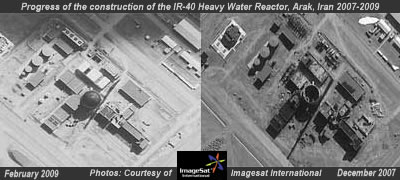Tehran continues its thrust to obtain nuclear military capability, showing no signs of suspending its uranium-enrichment efforts despite enconomic, political sanctions and security council’s pressure. Sustaining its effort in ‘fail safe’ approach, Iran is moving redundant paths toward its goal, deploying both uranium enrichment process and plutonium-producing heavy water reactor in two separate sites. Both efforts have a common objective – obtaining enough fissile material to build several nuclear devices within a few years time.
The visible path Tehran is moving through, is the Uranium enrichment process. Progress along this path is well documented, as Iran agreed to accept inspections by the International Atomic Energy Agency (IAEA). According to a recent report released by IAEA General Secretary on February 19, 2009, Iranian scientists are already operating close to 3,800 centrifuges in two separate units at Natanz. When completed, this facility is intended to house roughly 48,000 centrifuges, operated in a ‘cascade’ configuration, grouped in 16 unit stacks. The report confirms, that during the past two years Iran processed nearly 10 tons of UF6 through the cascades at Natanz, producing 839 kg of Uranium hexafluoride -also known as ‘Low Enriched UF6’ (LEU). This material contains U-235 at an enrichment level of 3.49% which is considered suitable for research and commercial applications. IAEA indicates Iran continues to operate its centrifuges near their expected capacity. In the past three month Iran’s cascades continued to produce additional 171 kg of LEU.
Tehran’s continued work on its enrichment program is being carried out in violation of five UN Security Council resolutions. Three of those resolutions have imposed penalties targeted at persons and entities, believed to be involved in Iran’s nuclear and missile programs. Tehran contested the security council’s position, insisting its enrichment operations are carried out under IAEA monitoring.
Related Analysis Posts by David Eshel:
10 Nov. 2007: Time to Call Ahmadinejad’s Provocative Bluff
7 Dec. 2005: Iran’s Point Defense Upgraded
4 April, 2004: Iran’s National Deterrent: Weapons of Mass Destruction Program
May 10, 2009: New Reactor Under Construction at Pakistan’s Nuclear Site
However, while openly ‘welcoming’ inspectors at the Natanz facility, Iran is reluctant to accept inspections at its heavy-water reactor at Arak, which has been under construction since 2006. Repeated requests to visit the sites were denied, most recently in November 2008.
The site has been monitored by satellite imagery since the beginning of the construction at the site in 2005. Most recently, construction has been progressed, with roofing being completed for supporting facilities and the construction of the reactor building’s domed containment structure has also been completed.
A satellite image obtained by Defense Update clearly shows the advanced stage of construction at this site. According to IAEA officials, the advanced stage of construction renders the continued use of satellite imagery impossible, in order to monitor further construction inside the reactor or any of the other related buildings. The site is located at the premises of Iran’s heavy water production plant, commissioned in August 2006. According to a recent IAEA inspection, this fuel manufacturing plant is already operational. The process line for the production of natural uranium pellets for the heavy water reactor fuel had been completed and fuel rods were being produced at the site.
Iran’s efforts to acquire a large, 40-megawatt heavy water-moderated “research” reactor are not new. During the 1990s, Iran secretly approached at least four nuclear suppliers and sought to purchase such a reactor. Suspicious of Iran’s motives, the governments all turned down the request. While Iran was deprived from its attempts to buy a complete 40-megawatt heavy-water reactor, it eventually got the technical assistance from an unspecified source, abroad necessary to build its own reactor.

It is not by coincidence that India’s Cirrus reactor, Pakistan’s Khushab reactor, and Israel’s Dimona reactor are all large, heavy-water reactors. Fueled by natural uranium, these reactors do not require their owners to go through the effort in obtaining enriched uranium fuel—either by making it indigenously or buying safeguarded enriched uranium from abroad. Moreover, when reprocessed, fuel rods irradiated in such reactors, yield high-quality weapons-grade plutonium. North Korea’s infamous 5-megawatt reactor at Yongbyon, while moderated with graphite, rather than heavy water, is also fueled with natural uranium. All of these reactors are excellent plutonium bomb factories. This was the main reason why they were acquired.
The planned reactor, the IR-40, will have a power of 40 megawatts thermal (MWth) and use natural uranium oxide fuel, which will be made at Esfahan. Construction is scheduled to be complete in 2011 and the reactor will achieve critical stage in 2013. If operating optimally, the reactor at Arak would produce about 9 kilograms of Pu-239 (plutonium) annually – enough to build one nuclear weapon every year. However, plutonium is not produced directly from the reactor, and will be separated in yet another facility before being ready for weaponization. Therefore, Iran is expected to be capable of producing its first plutonium based weapon by the middle of the next decade. Iran says its reactor at Arak will be used to produce isotopes for peaceful purposes. However, such a facility is far more powerful for such benign purposes. Much smaller, light-water research reactors are fully satisfactory for the kinds of applications Iran claims it is interested in. It is noteworthy that France, Germany, and the United Kingdom offered to replace Iran’s 40-megawatt heavy-water reactor with a light-water research reactor, but Iran was not interested in that offer.
Realizing Iran’s persistent striving toward the bomb, and the advanced stage of its infrastructure development, Israeli and US intelligence services already predicted several years ago, that Iran could have nuclear devices in its posession early in the next decade. This assessment has not changed, but seems to gain momentum.

















